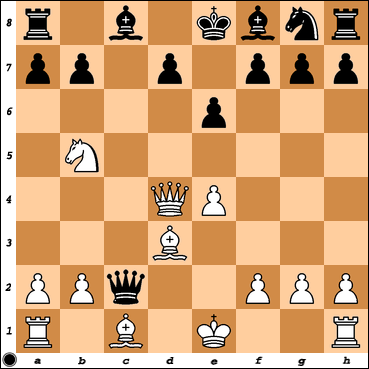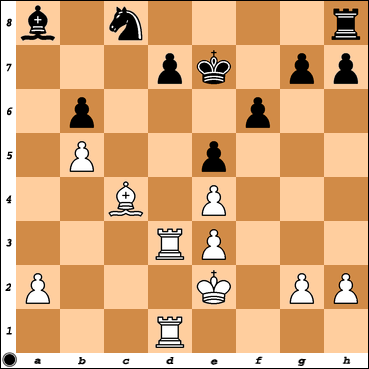Me - NN
Blitz 20 minutes
28.5.2008
1.e4 c5 2.Nf3 Nc6 6.3.d4 9.cxd4 4.Nxd4

Here black has three standard approaches the Accelerated dragon 4...g6, the Sveshnikov variation which seems to be the main line 4...Nf6 5.Nc3 e5, 4...e6 that is the Taimanov Sicilian and the Kalishnikov Variation 4...e5.
At least on databases accelerated variation seems to favour white. One of the ideas behind it is to put pressure on d4 but at the same time allows white to set up the Maroczy Bind with c4.
Accelerated dragon and Maroczy Bind:

In Svehnikov black forces action in the center and accepts weaker d5. To this square white will try to settle a knight or a bishop. Often in this line white plays Bc1-g5xf6 to further weaken Black's grip on d5. Black can then develop counterplay on the dark squares.
The Sveshnikov and weak d5 square for black:

The Taimanov Sicilian is described by John Donaldson on book review on JeremySilman.com to be one of the most flexible variations in sicilian and is considered quite sound and reliable.

So. Kalashnikov. One of the ideas behind it is that after 4...e5 5.Nb5 d6 white does not have pin with Bg5.
Kalashnikov after 4...e5 5.Nb5 d6:

But anyway back to the position after 4.Nxd4 where none of this happened:

My opponent played 4...Nxd4?
Curiously I found Dan Heisman talking about this move in a column he wrote for ChessCafe.com. It violates couple of very basic principles, it helps white develop another piece, it wastes one tempo moving same piece twice and so slows down blacks development at the same time as it accelerates whites.
5.Qxd4 e6 6.Nc3

So. Black has one pawn developed and white has three pieces out. In theory white is one move away from castling to either side. Black is two moves away. On Chessbase.coms databases black has two main moves ...a6 and ...Ne7 that have both played around 30 times. The close seconds are ...b6 and ...d7 that have been played around 10 times. ...Nf6 was played by near 2400 rating player Evarth Kahn who managed to draw against Denis Sallinikov a near 2300 player.
The strongest player on my database with known ranking who has played the position is Igor Mikhailovich Khrenov who was there twice a bit over rating 2400. He played ...Ne7.
I left my Rybka 2.32a 32-bit calculating and also it did come up with two moves where it considers at the depth of 21 and 22 white to be only slightly better: ...Ne7 and ...a6.
So I guess ...Ne7 is pretty strong. The lines that arise with quick look are quite even with slight plus for white.
For example:
6...Ne7 7.Nb5 Nc6 8.Nd6+ Bxd6 9.Qxd6 Qe7 10.Qxe7+ Kxe7 11.b3 d6 12.c3 Rd8 13.Be3 b3 14.0-0-0
With unclear position where white might be slightly better:

But anyway. This is after all 20 minute blitz game so I guess my opponent with almost 200 higher rating wanted to sharpen the position and chose:
6...Qc7?

Rybka at the depth of 13 ranks this as 20th best move in the position and thinks that after this white is better by +1.38. I'm not sure what this accomplishes but expose queen for harrasment. This does nothing to help black castle it does not develop any of blacks minor pieces or better pawn structure. And now after black's sixth move white is much better if not winning!
And so I and my fellow chessfanatic Fischer played the excellent and only 7.Nb5!

Funnilly enough in a game Steinar Hardersen - Amund Nergaard resigned at this point. It does not come easy to black from this position to do anything. Especially as we are in blitz game and black has feeling that the brilliancy of previous move should become apparent rather sooner then later.
The best move seems to be Qb8!
The position is just terrible but white still needs some good moves before anything should happen. It is just mentally very difficult to submit to this move.
For instance:
7...Qb8! 8.Qc3 Kd8 9.g3 f6 10.Bf4 e5 11.Be3 Nh6 12.Be2 b6 13.0-0 a6 14.Na3

So. I can understand my opponent choosing Qxc2. And here is where I believe I outplayed Fischer.
Not many such occassions arise in my chess career so I proudly give you:
8.Bd3!

Naturally this is good not only because this develops yet another piece but also this puts black queen on a difficult spot. There is nowhere to go but Qc6 and black spends yet another tempo without anything concrete to show that is achieved. Nb5 knight looks hungrily for spot in c7 to fork rook and king all the time.
Fischer played 8.Bf4? and his opponent replied with excellent ...Bc5!

Suddenly white is only slightly better. Whites best take on the situation which Fischer also took is to go to 9.Qd2 let his opponent have e4 pawn by 9...Qxe4+.
Here Fischer essentially has lost the momentum but gets it back later even the game continued 10.Be2 Bb4 11.Nd6+ 12.Bxd6

Here black has iniative and queen on central position ready to grab g2 pawn for starters and then better his position. But here Tordion played unenergetically and Fischer played more accurately and eventually equalized and got better of his opponent. If Fischer is not loosing the position it is easy to see it is complicated and far from where I got with my Bd3!

8...Qc6 9.Bf4!

I develop yet another piece and have really strong spot on e7 where I still threaten to fork.
Here white still has a long way to go. The best reply from black would have probably been 9...f6.
For instance:
9..f6 10.Nc7+ Kd8 11.Nxa8 b6 12.Nxb6 axb6 13.Rc1 Bc5 14.Qc3 e5 15.Be3 Bxe3 16.fxe3

White is the exchange knight for a rook better but position is unclear and there is work and effort required to acquire the victory.
Black might want to exchange queens and white to develop his b-pawn and double his rooks. For instance:
16...Qxc3+ 17.Rxc3 Bb7 18.Ke2 Ne7 19.Rd1 Bc6 20.b4 Nc8 21.b5 Ba8 22.Bc4 Ke7 23.Rcd3

But. Here my opponent thought about position about two minutes, did not come with anything better, stumbled and played the aggressive looking but uninspired Bc5?

It is a loosing move at least in this game. He hungs his g pawn and eventually rook:
10.Qxg7! Bb4+ 11.Ke2!

Here black resigned.
One possible line would have been:
11..e5 12.Bxe5 Qh6 13.Nc7+ Kd8 4.Qxh8 Qd2+ 15.Kf1 Qxd3+ 16.Kg1 d6 17.Nxa8

Pictoresque position that tells lot about my current concept of the game. I have startered to wonder how much using Rybka has influenced my game. I guess it is somewhat. I don't think positionally but I think in material and in tactics.
Black queen is in the middle influencing the game and all my pieces but bishop are close to edges. Both sides have open warfare where shots are given and taken. It is more about exchanging, tactics then long term strategy.


